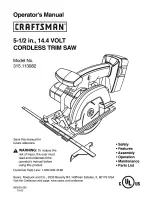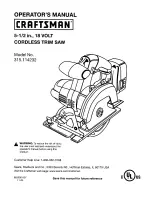
10
OPERATION
•
Tighten the outer blade flange (3). First tighten blade bolt (4) to finger tight. Use the
saw blade wrench to apply counterpressure to the flange (3). Tighten blade bolt (4)
firmly with the allen key supplied with the machine.
•
Before connecting the saw to a power source, ensure that:
- The blade (1) rotates freely;
- The lower blade guard (20) operates correctly.
NOTE:
Do not modify the blade spanner to elongate it, since it may lead to over tightening
of the blade bolt (4).
ADJUSTING THE CUTTING DEPTH
Loosen the depth adjustment lever (14). Hold the base plate (5) down with one hand and
raise or lower the saw by the back handle (8). Tighten depth adjust lever (14) at the desired
depth setting.
To obtain minimum splintering while operating, ensure that no more than one tooth
protrudes through the timber.
NOTE:
During bevel cutting the depth set on scale (13) does not coincide with the real
depth value. In this case the depth should be measured from the tip of the tooth to the
edge of the slot in the base plate with a measuring tool.
ADJUSTING THE BEVEL
Vertical cutting
Set maximum cutting depth. Loosen bevel adjustment lever (25), set it to 0º on bevel scale
(23), retighten bevel adjustment lever (25) and check for 90º angle between the blade (1)
and bottom plane of the base plate (5) with a square.
Bevel cutting
The base plate (5) can be adjusted to 0°–45°. Loosen the bevel adjustment lever (25). Align
it to the desired angle on calibrated bevel scale (23). Then tighten bevel adjustment lever
(25).
Due to the increased area of blade engagement in the work and decreased stability of the
base plate, blade binding may occur. Keep the saw steady and the press the base plate
firmly on the work piece.
Use a protractor when you have to set a precise angle.
EN











































